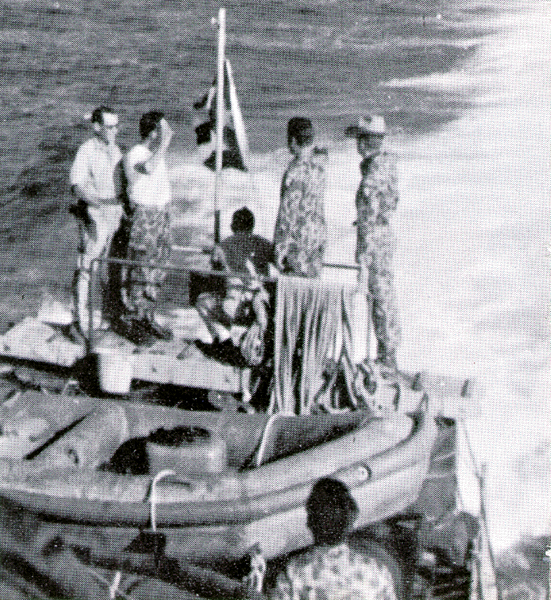The Bay of Pigs Invasion was a failed US-supported landing on Cuba against Fidel Castro’s Communist Cuba in 1961. Here, J.J. Valdes considers Britain’s involvement in the affair.
Bay of Pigs Invasion: The flagship Blagar, near the Cuban coast, April 16, 1961.
“Speak in English,” Bob Hines, radio operator at the airport tower in Grand Cayman, kept telling the Spanish-speaking pilot of the Douglas B-26 Invader circling overhead. There was no scheduled arrival of a plane on that early morning of April 15, 1961, so Hines was perplexed about the identity of the unexpected flight. Hines spoke some Spanish and could understand that the pilot was asking for landing instructions. Unable to get the man to communicate in English, he gave him instructions in Spanish as best he could and the plane finally landed.
The radio operator, who was working alone in the tower at the time, then went out to meet the plane on the tarmac. The pilot, in military garb, was the first to exit the aircraft, which bore Cuban air force markings. “Give you this,” he said to Hines, holding two pistols in his outstretched hand. Hines took the pistols then, deciding that this was something for the government to handle, summoned the islands’ Immigration Officer (also the Chief of Police) and Administrator Jack Rose.
Cayman Islands
The Caymans, consisting of Grand Cayman and two other smaller isles, came under British rule in 1670. In 1961 the territory was administered as a dependency of Jamaica, where the governor resided. Jack Rose, a former Royal Air Force (RAF) fighter pilot during World War II, was the island’s resident administrator.
Rose quickly arrived at the airport. The Cubans were demanding to be flown to Miami and at first Rose assumed that they were defectors from that country. But in fact, the unexpected arrivals were Cuban exile pilot Alfredo Caballero and navigator Alfredo Maza. They were part of a force trained in Central America by the Central Intelligence Agency (CIA) for an invasion of Cuba intended to topple Fidel Castro. Their plane was one of three B-26s that had attacked San Antonio de los Baños airbase, near Havana, as part of pre-invasion strikes on three of the country’s main airfields. Caballero had discovered en route to Cuba from Nicaragua that there was a malfunction with the plane’s droppable fuel tanks. Despite his flight leader’s order to turn back, he had opted to continue with the mission. However, his fuel situation had become critical on the return trip, forcing him to divert to Grand Cayman.
No one had bothered to inform Rose about the possible arrival of such visitors and he was “far from pleased to see them” because he “smelt trouble.” Adding to his foreboding was the fact that one of the plane’s rockets had apparently misfired and was still attached under a wing. The Cuban crew offered no cooperation in addressing the dangerous situation. Rose, therefore, called on his old RAF skills to remove the device and other ordnance from the plane with help from ground personnel and an American tourist onlooker who had been a bomber crewman.
Rose’s next order of business was to contact the governor in Jamaica, Sir Kenneth Blackburne. As there was no telephone connection at the time between Kingston and the Caymans, messages had to be exchanged via radiotelegraphy. Blackburne, it turned out, was as surprised as Rose by the incident and had little to offer. This left Rose in a crux regarding “what attitude to adopt in practical and propaganda terms.” He thought it prudent “to try to keep the lid on what had happened.” Thus, in addition to requesting local ship owners to refrain from radio chatter about the B-26’s arrival, he arranged for the postmaster to hold off all outgoing mail for a time.
Lack of knowledge
Even the highest levels of the British government had apparently not been informed by the Americans of their plans for an invasion of Cuba, let alone that an airstrip on British territory had been designated as an emergency landing alternative. British Prime Minister Harold Macmillan, despite his close association with President John F. Kennedy, had been kept in the dark about such plans when he had visited Washington in early April. The American strategy seemed to have been not to involve the British authorities pending the advent of actual emergency landings on the Caymans. If the British then decided to intern any landed aircraft, the Americans considered raising the specter that Cuba and other nations might view the planes’ presence there as indicative that the islands were being used as a launch base.
As it happened, however, the British government proved most cooperative. During the evening, Rose received a radiogram from Sir Blackburne informing him to expect “a visitor” during the night who “should be given every courtesy.” Around midnight, a transport aircraft with no landing lights approached the dark runway (which lacked an illumination system) at low level. Upon touching down, the “visitor” and several other CIA men deplaned. The leader of the group introduced himself and, over the course of their conversation, revealed to be intimately acquainted with assorted details about Rose’s life. The rest of the group consisted of aviation technicians who immediately set to work on the parked B-26.
After sizing up the situation, the lead CIA man indicated that he needed to phone Washington. He initially thought Rose was joking when the latter informed him that the island had no telephone connection to the outside world. Arrangements were then made via radiogram for a charter plane from Jamaica to pick up the American in the morning and fly him there so he could make his call. Afterward, he returned on the plane to Grand Cayman. Rose came to find out that, to pay for expenses, this fellow carried a case containing stacks of US paper currency, “neatly packed just as one sees them in films or television as ransom money.”
Events took a precipitous turn on April 17 when the disembarkation of troops at the Bay of Pigs began. Throughout the day, the invasion force received air support from B-26 bombers arriving over the area from Nicaragua in staggered fashion. The aircraft, which lacked tail guns, were often engaged in lopsided aerial battles by fighter planes from Castro’s air force. By day’s end, two more B-26s had arrived at Grand Cayman. One, piloted by Marío Zúñiga, diverted there in the early morning low on fuel after engaging in a dogfight with, ironically, a British-made Hawker Sea Fury. A number of the prop fighters had been inherited by Castro from former Cuban dictator Fulgencio Batista. Another B-26, piloted by Antonio Soto, arrived in the early afternoon after having one of his engines shot out by a T-33 jet.
In retrospect
Both Rose’s and Hines’s oral accounts, recorded more than three decades after the events, are imprecise in various respects, including the total number of B-26s, each carrying a two-man crew, that diverted to Grand Cayman. Whereas they both claim that a total of four planes arrived, CIA documents indicate that only three did, including Caballero’s on the 15th. The three aircraft were flown back to Nicaragua by CIA personnel as soon as each was made airworthy. Meanwhile, the six Cuban exile crewmen they had carried were issued civilian clothes and flown out on regular air service flights to Miami. Zúñiga and Soto arrived back in Nicaragua in time to join the invasion’s most devastating air support mission late on the afternoon of April 18. Caballero, however, was transported by mistake to Retalhuleu, the CIA’s airbase in Guatemala, and remained there until the invasion’s collapse on April 19.
Both Administrator Rose and Governor Blackburne subsequently received letters of commendation for their handling of the affair from the British Permanent Under-Secretary of State for Foreign Affairs, Sir Frederick Millar. However, Rose was “given to understand” that if the matter had attracted any adverse publicity, he alone would have been assigned blame for the incident.
The role of British territory in the CIA’s Cuban invasion has largely remained hush and been little publicized over the years. Radio operator Hines declared in his 1995 oral account that he “was the only person allowed to take pictures [of the landed planes], on word that I would not publish them; I have never published them.” To this day, the pictures have never come to light.
Author J.J. Valdes’s recent book about the 1961 Cuban invasion is Besieged Beachhead: The Cold War Battle for Cuba at the Bay of Pigs. Available here: https://www.amazon.com/Besieged-Beachhead-Cold-Battle-Cuba/dp/0811776794
Sources
Beerli, Stanley W. “Transmittal of Documents.” Memorandum to Lt. Colonel B. W. Tarwater, USAF (Attachment C), April 26, 1961. https://www.cia.gov/readingroom/docs/DOC_0000252273.pdf.
Lesley Hines. “Interview with Lesley (Bob) Hines.” By Heather McLaughin. Cayman Islands National Archive Oral History Programme (16 February 1995; finalized transcription: 16 April 1997)
Pfeiffer, Jack B. Official History of the Bay of Pigs Operation. Vol I. Central Intelligence Agency, 1979.
Jack Rose. “Interview with Jack Rose.” By Heather McLaughin. Cayman Islands National Archive Oral History Programme (18 May 1999; finalized transcription: 22 July 1999).
Sandford, Christopher. Harold and Jack: The Remarkable Friendship of Prime Minister Macmillan and President Kennedy. Amherst, New York: Prometheus Books, 2014.
Valdés, J.J. Besieged Beachhead: The Cold War battle for Cuba at the Bay of Pigs. Essex, Connecticut: Stackpole Books, 2024.
Wells, Davis. A Brief History of the Cayman Islands. Dover, UK: The West India Committee, 2018. eBook. https://www.cigouk.ky/downloads/Cayman-Islands-e-book-October2018.pdf.
Wise, David, and Thomas B. Ross. The Invisible Government. New York: Random House, 1964.







